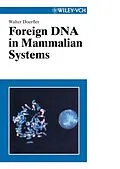Es ist unwahrscheinlich, daß bestehende Genome heutiger Organismen für immer stabil sind, und es ist denkbar, daß fremde DNA Eingang in einzelne Zellen eines Organismus finden kann.
Unter fremder DNA wird genetisches Material verstanden, das aus einem anderen Organismus derselben oder einer anderen Spezies stammt. Alle Organismen sind, insbesondere durch die tägliche Nahrungsaufnahme, fremder DNA ausgesetzt. Bislang ist sehr wenig über Abwehrmechanismen gegen die Aufnahme fremder DNA bekannt. Zumindest in Zellkulturen kann der Einbau fremder DNA in das Genom gezeigt werden.
Der Autor - selbst seit über 30 Jahren mit dieser Fragestellung beschäftigt - hält es zu diesem Zeitpunkt, da in nahezu allen modernen Forschungsgebieten der experimentellen Biologie und Molekularmedizin mit fremder DNA gearbeitet wird, für wichtig, Phänomene und Mechanismen der Wechselwirkung von fremder DNA und Säugerzellen und -organismen zu untersuchen.
Autorentext
Walter Doerfler studied medicine in Munich, Erlangen and Hamburg. After that, he was intern at Mercer Hospital Trenton , NJ , USA. He held postdoctoral degrees from 1961 to 1963 at the Max Planck Institute of Biochemistry in Munich and from 1963 to 1966 at the Department of Biochemistry, Stanford University Medical School.
Klappentext
The established genomes of today's organisms are unlikely to remain stable forever. Foreign DNA can gain access to individual cells of an organism. Foreign DNA is genetic material derived from another organism of the same or a different species. The natural environment is heavily "contaminated" with foreign DNA. Viruses and microorganisms are ubiquitous. The soil contains considerable amounts of DNA. In mammals, like in all other species, the gastrointestinal tract is constantly exposed to foreign DNA from the food supply. There is no information on defense mechanisms against foreign DNA. The huge surface of the gastrointestinal tract is, of course, protected by an extensive immune system. The author's laboratory has investigated the fate of foreign in particular adenoviral DNA in mammalian cells. Foreign DNA integration, de novo methylation, and the consequences of foreign DNA insertion into established mammalian genomes are the main topics of this book. New concepts for viral oncogenesis are deduced from the results of basic research in molecular virology.
Zusammenfassung
It is unlikely that the established genomes of present day organisms remain stable forever. It is conceivable that foreign DNA can gain entry into individual cells of an organism.
Foreign DNA is defined as genetic material that derives from another organism of the same or a different species. The natural environment is heavily "contaminated" with such foreign DNA, and mammals, like other organisms, are frequently exposed to foreign DNA in their environment, notably by ingesting their daily food supply. By necessity, the gastrointestinal tract also of all mammalian organisms is constantly in contact with foreign DNA. So far, next to nothing is known about defense mechanisms in mammals against the intrusion of foreign DNA. At least in cells growing in culture, the uptake and genomic fixation by integration of foreign DNA can readily be demonstrated.
For a number of reasons, the author has considered it important to investigate the phenomena and mechanisms involved in the interaction of foreign DNA with mammalian cells and organisms in detail.
Inhalt
Introduction
MOLECULAR BIOLOGY
Uptake of Foreign DNA
Modes of Persistence of Foreign DNA
Integrative Recombination
Expression of Integrated Foreign DNA
De novo Methylation of Foreign DNA
Alterations of Cellular DNA Methylation Patterns
Consequences for Cellular Gene Expression Patterns
Insertional Mutagenesis
Experiments in Cell Culture and with Animals
Uptake of Foreign DNA via the Gastrointestinal Tract
RELEVANCE FOR DIFFERENT BIOLOGICAL PROBLEMS
Oncogenic Viruses
Tumor Biology
Reverse Genetics
Transgenic Organisms
Mutagenesis
Human Somatic Gene Therapy
Injection of DNA into Animals and DNA Vaccines
Uptake of Foreign DNA via the Gastrointestinal Tract and Human Nutrition
Thoughts on Evolution
Gene Technology and Biosafety
FUTURE RESEARCH
GENERAL IMPACT
References
